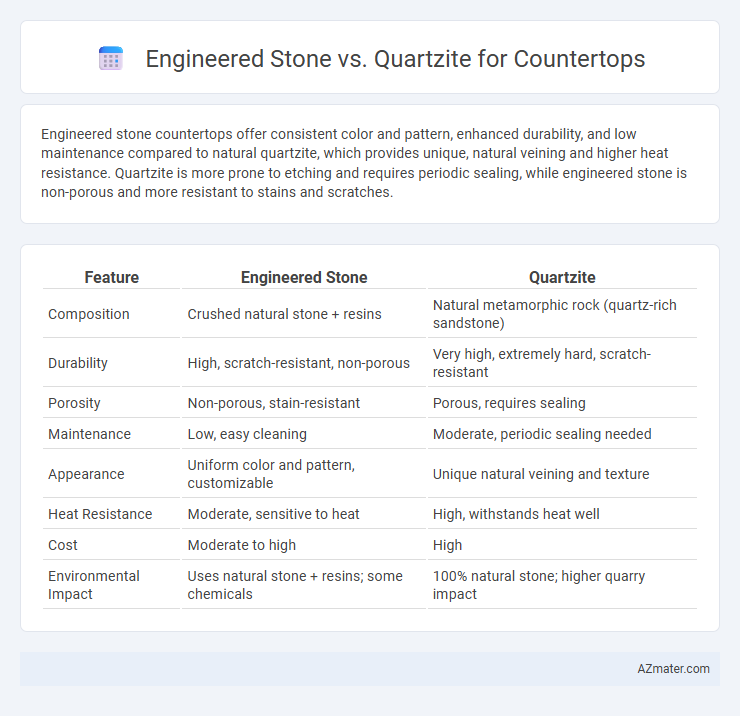Engineered stone countertops offer consistent color and pattern, enhanced durability, and low maintenance compared to natural quartzite, which provides unique, natural veining and higher heat resistance. Quartzite is more prone to etching and requires periodic sealing, while engineered stone is non-porous and more resistant to stains and scratches.
Table of Comparison
| Feature | Engineered Stone | Quartzite |
|---|---|---|
| Composition | Crushed natural stone + resins | Natural metamorphic rock (quartz-rich sandstone) |
| Durability | High, scratch-resistant, non-porous | Very high, extremely hard, scratch-resistant |
| Porosity | Non-porous, stain-resistant | Porous, requires sealing |
| Maintenance | Low, easy cleaning | Moderate, periodic sealing needed |
| Appearance | Uniform color and pattern, customizable | Unique natural veining and texture |
| Heat Resistance | Moderate, sensitive to heat | High, withstands heat well |
| Cost | Moderate to high | High |
| Environmental Impact | Uses natural stone + resins; some chemicals | 100% natural stone; higher quarry impact |
Introduction to Engineered Stone and Quartzite Countertops
Engineered stone countertops consist of crushed quartz mixed with resin and pigments, offering consistent patterns and a variety of color options with non-porous, low-maintenance surfaces. Quartzite, a natural metamorphic rock formed from sandstone, provides exceptional durability and heat resistance with unique, natural veining patterns that enhance aesthetic appeal. Both materials are popular in kitchens for their strength and elegant appearance, but engineered stone offers more uniformity while quartzite delivers distinct, natural beauty.
Composition and Manufacturing Differences
Engineered stone countertops consist of approximately 90% crushed natural quartz combined with resins and pigments, allowing for uniform color and pattern consistency. In contrast, quartzite is a natural metamorphic rock primarily composed of quartz grains fused under high heat and pressure, offering unique veining and hardness. Manufacturing engineered stone involves a controlled process of blending and curing materials in slabs, while quartzite slabs are quarried and cut directly from natural stone deposits.
Appearance and Aesthetic Variations
Engineered stone countertops offer consistent color and pattern choices, providing a sleek and uniform appearance ideal for modern kitchen designs. Quartzite features natural veining and unique color variations, delivering a more organic and luxurious aesthetic that emphasizes natural stone's beauty. Both materials provide diverse options, but quartzite's intricate patterns create a distinct visual character unmatched by engineered alternatives.
Durability and Hardness Comparison
Engineered stone countertops, composed primarily of crushed quartz and resin, offer enhanced durability with resistance to stains, scratches, and impact due to their non-porous surface and uniform hardness rating of approximately 7 on the Mohs scale. Quartzite, a natural metamorphic rock, ranks higher in hardness around 7 to 8 on the Mohs scale, making it extremely resistant to scratching and heat, but its porous nature requires regular sealing to maintain durability against staining. For longevity in kitchen use, engineered stone provides consistent protection with minimal maintenance, while quartzite boasts superior natural hardness but demands careful upkeep to preserve its appearance and structural integrity.
Maintenance and Cleaning Requirements
Engineered stone countertops require minimal maintenance due to their non-porous surface, which resists stains and bacterial growth, making regular cleaning with mild soap and water sufficient. Quartzite countertops, composed of natural stone, need periodic sealing to prevent staining and etching, alongside gentle cleaning with pH-neutral cleaners to preserve their finish. Both materials demand avoiding harsh chemicals and abrasive tools to maintain surface integrity and longevity.
Stain and Heat Resistance Factors
Engineered stone countertops, made from a mixture of crushed quartz and resin, offer superior stain resistance due to their non-porous surface that prevents liquids from seeping in. Quartzite, a natural metamorphic rock, provides excellent heat resistance, often withstanding temperatures up to 1200degF, making it ideal for hot pots and pans. While quartzite is more heat tolerant, engineered stone requires caution with hot items but excels in resisting stains from oils, wine, and acidic substances.
Cost Differences Explained
Engineered stone countertops typically cost between $50 and $100 per square foot, offering a more budget-friendly option compared to natural quartzite, which ranges from $70 to $120 per square foot due to its rarity and extraction expenses. The manufacturing process of engineered stone allows for consistent pricing and availability, whereas quartzite's cost fluctuates based on natural quarry extraction and stone quality. Homeowners seeking durable surfaces may choose engineered stone for cost efficiency, while quartzite remains preferred for its unique natural patterns despite higher investment.
Installation Considerations
Engineered stone countertops offer consistent thickness and uniformity, simplifying the installation process and reducing the risk of errors during cutting and fitting. Quartzite, being a natural stone with variable hardness and veining, requires specialized tools and experienced installers to handle its brittleness and weight, increasing installation time and costs. Proper substrate preparation and adequate support are critical for both materials, but quartzite demands extra caution to prevent surface cracking due to its natural fissures.
Environmental Impact and Sustainability
Engineered stone countertops utilize resin and crushed quartz, leading to concerns over synthetic chemical emissions and limited recyclability, while quartzite is a natural, durable stone with minimal processing emissions and better end-of-life recyclability. Quartzite's extraction can cause habitat disruption and high energy use in mining, yet its longevity and natural composition often result in a lower overall environmental footprint compared to engineered stone's manufacturing and disposal impacts. Choosing quartzite supports sustainability through natural resource use and recyclability, whereas engineered stone requires evaluation of resin content and potential environmental hazards throughout its lifecycle.
Pros and Cons Summary: Engineered Stone vs Quartzite
Engineered stone countertops offer consistent patterns, low maintenance, and high stain resistance due to their non-porous surface, making them ideal for busy kitchens. Quartzite provides exceptional natural beauty and superior heat resistance but requires regular sealing to prevent staining and etching. While engineered stone combines durability with ease of care, quartzite offers unique, natural aesthetics at the cost of more intensive upkeep.

Infographic: Engineered stone vs Quartzite for Countertop
 azmater.com
azmater.com